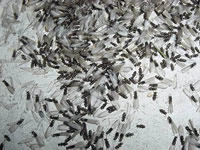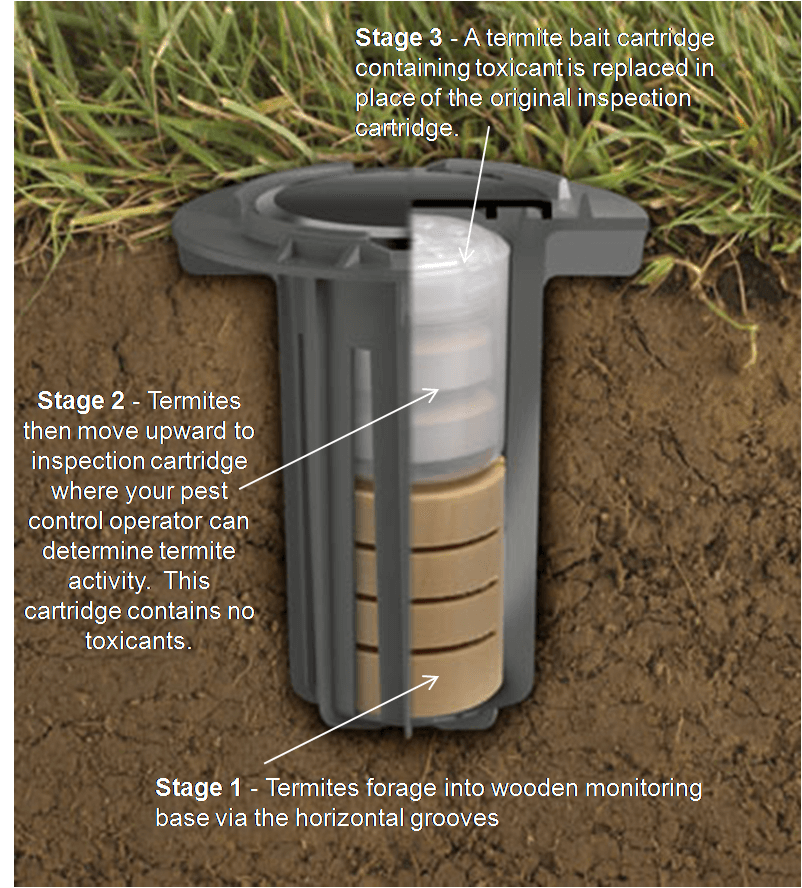
Subterranean termites are small, destructive insects that feed on wood. Left untreated, they can reduce your home to sawdust.
Gman provides high-quality, environmentally-friendly termite control in Westchester County, Rockland County, Dutchess County, Orange County, Putnam County, Ulster County, Queens, Brooklyn, Manhattan, Bronx, Long Island and Southern Columbia County in New York.
Termite Control
Termites are small, highly social insects that feed on wood. They're also a homeowner's worst nightmare. Untreated, a termite colony can literally eat you out of house and home.
The termites that do the damage live in the soil and travel through mud shelter tubes, so they're not usually seen by homeowners. The ones that homeowners usually see are the "alates," or "swarmers," shown in the picture on the right, which are reproductive termites that are leaving the colony to start their own.

Unfortunately, by the time you see alates, that means the colony has doing damage for a long time, because only mature termite colonies produce swarmers.
No worries. G-Man Exterminating provides environmentally-friendly termite solutions throughout Dutchess County, Orange County, Putnam County, and Columbia County in New York. We also offer a Limited Lifetime Renewable Termite guarantee. That's right -- lifetime.Our warranty is the best in the industry. We'll also beat most written estimates for Termite control and give a longer guarantee, because we buy factory direct and pass the savings on to you.
Your house is the biggest investment most people will ever make. Termites will turn your house into an all-you-can-eat buffet. Call us now and we will take your home off the dinner menu.
Frequently Asked Questions About Termites
Termites are wood-destroying insects. Their presence dates back to the dinosaurs. While they play an important role in nature, experts estimate they cause $5 billion of property damage each year.
Yes, the three major kinds of termites in the United States are dampwood, drywood and subterranean. Dampwood termites commonly live in heavily forested areas of the country as they prefer wet wood; while, drywood termites, much more rare in the United States, prefer extremely dry wood. Subterranean termites require moist environments, live mainly in the soil and are the most destructive species.
Depending on your geographical location, termite swarms should be visible in the early spring. Termite swarms can be confused with flying ants. Termites shed wings, often leaving files of wings; ants don't shed wings. Telltale signs of termite infestation include soft wood in the home, mud tubes in the interior or exterior of your home (often near the foundation), and darkening or blistering of wood structures.
Termites are social insects that live in colonies. Each termite has a specific role in the colony. The queen lays the eggs - possibly several thousand each day in some kinds of termites. Workers termites are the only ones that cause damage to wood - their job is to gather food and enlarge the colony. Soldiers have huge heads and long jaws they use to protect the colony from enemies. The termites that you may see are the winged reproductives that swarm in early spring.
It is often said that there are two kinds of homes: those that have had termites and those that will get them. Termites work 24 hours/7 days a week at damaging the wood in and around a structure. And, while they cause $5 billion in damage each year, there is no reason to think that termites cannot be controlled.
Termites swarm in the early spring, depending on their geographical location.
The most important thing is to remove the conducive conditions termites need to survive. Termites love moisture; avoid moisture accumulation around the foundation of your home. Divert water away with properly functioning downspouts, gutters and splash blocks. Reduce humidity in crawl spaces with proper ventilation. Prevent shrubs, vines and other vegetation from growing over and covering vents. Be sure to remove old form boards, grade stakes, etc., left in place after the building was constructed. Remove old tree stumps and roots around and beneath the building. Most importantly, eliminate any wood contact with the soil. An 18-inch gap between the soil and wood portions of the building is ideal. It doesn't hurt to routinely inspect the foundation of your home for signs of termite damage.
Homeowner's insurance typically does not cover termite damage.
Termites are nearly impossible for homeowners to treat on their own. On the other hand, pest control professionals have the training, expertise and technology to eliminate termite infestations.
Just as you wouldn't prescribe medicine for yourself or drill your own cavities - you shouldn't attempt to control termites - or other pests -- on your own. The products, equipment and expertise offered by a Pest Management Professional far surpasses what a homeowner could do on his own. The cost of professional protection is well worth the investment.
Termites are a problem in homes from New England to Florida, throughout the Midwest and to California. All states except Alaska have some degree of termite pressure. Having your home preventatively treated with the Advance Termite Bait System is a sound decision to protect your largest investment.
Advance Termite Bait System
Why choose the Advance Termite Bait System?
Fast long term control, continuous protection.
Entire colony is eliminated compared to liquid applications where only part of the colony is eliminated.
Less invasive to the home. The stations are installed outside the home with no landscape disruption or invasive drilling to your foundation.
Low impact on the environment, family, and pets as the bait is locked away in a secure station.
A sturdy bait station to minimize tampering and damage from lawnmowers, pets, and children.
The latest advancement in termite bait technology features a dual stage process that has a low disturbance designed to mimic the termites natural feeding behavior leading to enhanced colony elimination.


Call us for information on our inspection estimates and evaluations for termite control.
